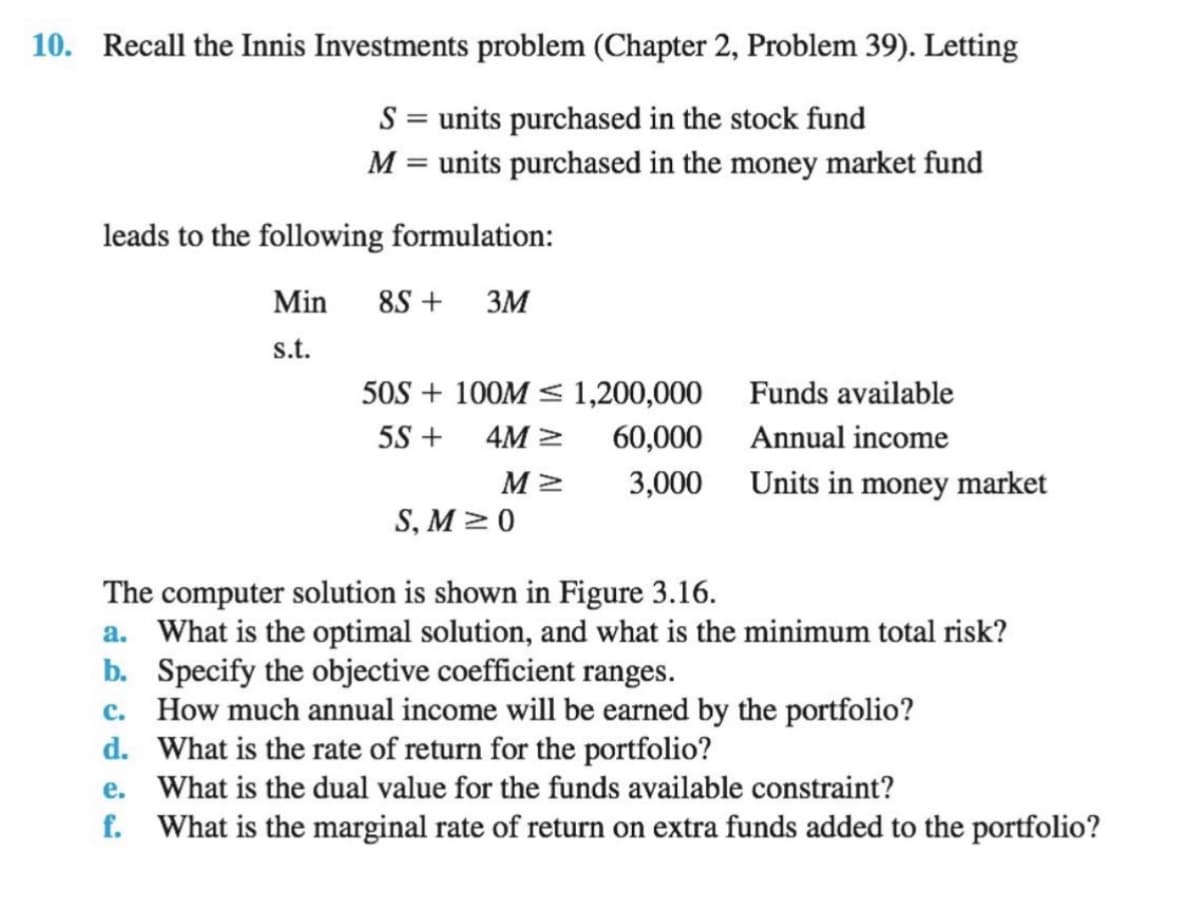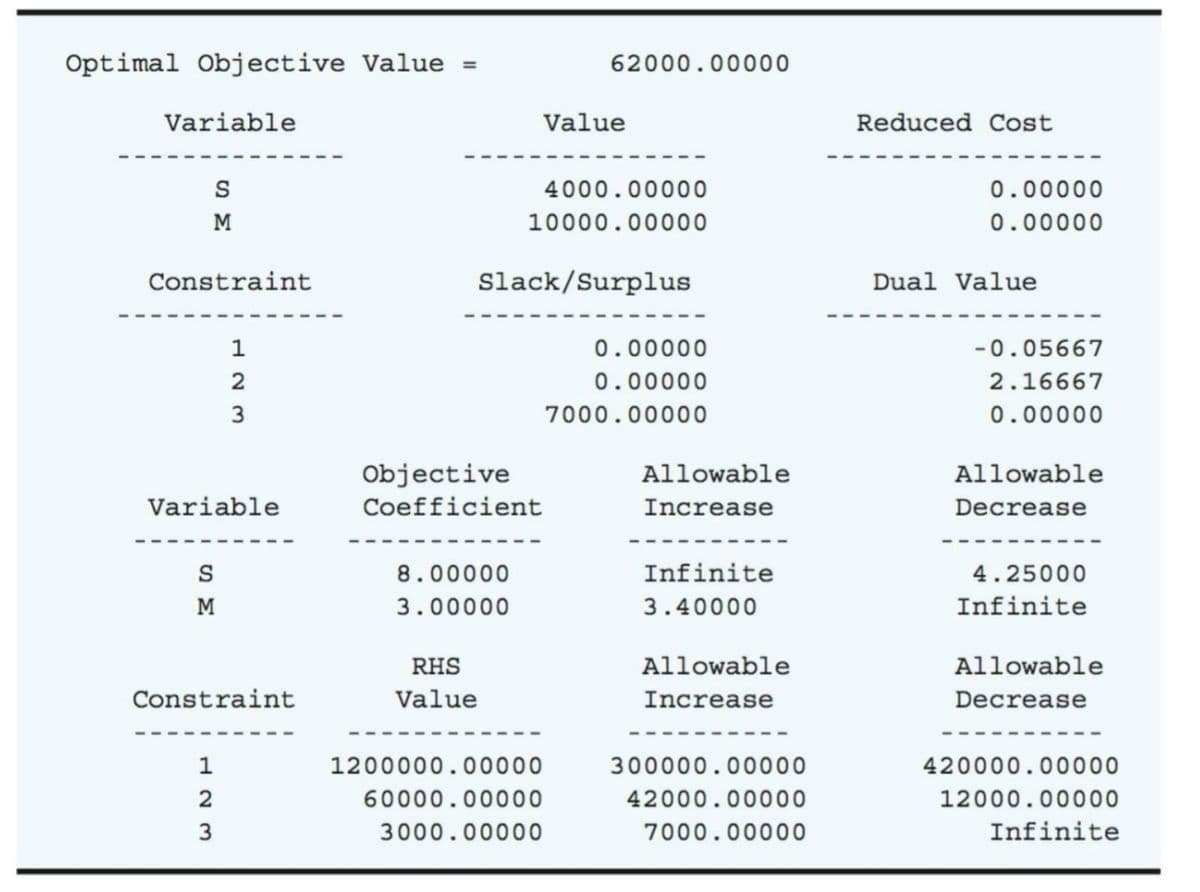10. Recall the Innis Investments problem (Chapter 2, Problem 39). Letting S = units purchased in the stock fund M = units purchased in the money market fund leads to the following formulation: Min 8S + 3M s.t. 50S + 100M < 1,200,000 Funds available 5S + 4M > 60,000 Annual income 3,000 Units in money market S, M > 0 The computer solution is shown in Figure 3.16. a. What is the optimal solution, and what is the minimum total risk? b. Specify the objective coefficient ranges. c. How much annual income will be earned by the portfolio?
10. Recall the Innis Investments problem (Chapter 2, Problem 39). Letting S = units purchased in the stock fund M = units purchased in the money market fund leads to the following formulation: Min 8S + 3M s.t. 50S + 100M < 1,200,000 Funds available 5S + 4M > 60,000 Annual income 3,000 Units in money market S, M > 0 The computer solution is shown in Figure 3.16. a. What is the optimal solution, and what is the minimum total risk? b. Specify the objective coefficient ranges. c. How much annual income will be earned by the portfolio?
Practical Management Science
6th Edition
ISBN:9781337406659
Author:WINSTON, Wayne L.
Publisher:WINSTON, Wayne L.
Chapter8: Evolutionary Solver: An Alternative Optimization Procedure
Section8.7: Portfolio Optimization
Problem 14P
Related questions
Question

Transcribed Image Text:10. Recall the Innis Investments problem (Chapter 2, Problem 39). Letting
S = units purchased in the stock fund
M = units purchased in the money market fund
leads to the following formulation:
Min
8S +
3M
s.t.
50S + 100M < 1,200,000
Funds available
5S +
4M >
60,000
Annual income
3,000
Units in money market
S, M > 0
The computer solution is shown in Figure 3.16.
a. What is the optimal solution, and what is the minimum total risk?
b. Specify the objective coefficient ranges.
c. How much annual income will be earned by the portfolio?
d. What is the rate of return for the portfolio?
e. What is the dual value for the funds available constraint?
f. What is the marginal rate of return on extra funds added to the portfolio?

Transcribed Image Text:Optimal Objective Value =
62000.00000
Variable
Value
Reduced Cost
S
4000.00000
0.00000
M
10000.00000
0.00000
Constraint
Slack/Surplus
Dual Value
1
0.00000
-0.05667
2
0.00000
2.16667
7000.00000
0.00000
Objective
Allowable
Allowable
Variable
Coefficient
Increase
Decrease
8.00000
Infinite
4.25000
M
3.00000
3.40000
Infinite
RHS
Allowable
Allowable
Constraint
Value
Increase
Decrease
1
1200000.00000
300000.00000
420000.00000
2
60000.00000
42000.00000
12000.00000
3
3000.00000
7000.00000
Infinite
Expert Solution
This question has been solved!
Explore an expertly crafted, step-by-step solution for a thorough understanding of key concepts.
This is a popular solution!
Trending now
This is a popular solution!
Step by step
Solved in 5 steps

Recommended textbooks for you

Practical Management Science
Operations Management
ISBN:
9781337406659
Author:
WINSTON, Wayne L.
Publisher:
Cengage,

Practical Management Science
Operations Management
ISBN:
9781337406659
Author:
WINSTON, Wayne L.
Publisher:
Cengage,